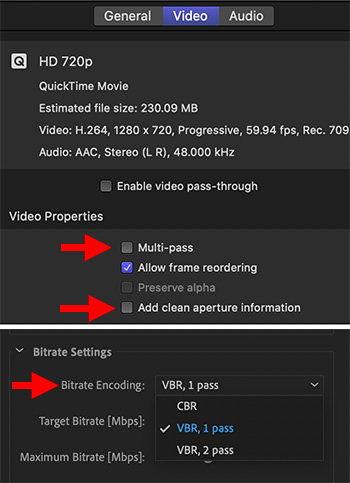Tip #1210: Tips for Faster Video Compression
… for Codecs & Media
Tip #1210: Tips for Faster Video Compression
Larry Jordan – LarryJordan.com
These settings can disable hardware acceleration, without benefitting the image.


Last week, I wrote about the hardware acceleration provided by both the T-2 and M-1 chips in Apple computers Tip #1190. As well, most current Intel CPUs also support hardware acceleration of 8-bit H.264 and HEVC media.
However, it is possible to accidentally turn OFF hardware acceleration by changing one setting in either Apple Compressor or Adobe Media Encoder.
NOTE: I can’t think of a single good reason to do this, so, um, don’t do it.
SETTING 1 – COMPRESSOR
Hardware acceleration is always single pass. Enabling multi-pass turns off hardware acceleration. (The top screen shot illustrates this setting in Apple Compressor.)
SETTING 2 – ADOBE MEDIA ENCODER
AME has two Bit Rate settings that can turn off hardware acceleration: CBR and VBR 2-pass. For fastest compression be sure to always select VBR 1-pass.
EXTRA CREDIT
In the past, we used 2-pass software compression because it looked better. Based on my observations, using today’s CPUs, hardware-accelerated compression looks as good as, or better than, media compressed using software.
And, it finished a WHOLE LOT faster, as well.
In Apple Compressor, for digital images, you can also turn off Clean Aperture. Tip #1211 explains why.


I have been under the (possibly mistaken?) impression that multi-pass was better because it meant that the video clip being compressed is examined through once before decisions about an overall data rate are made. Meaning, for example, if there is a section of the video near the end of the clip that has a lot of detail and motion (requiring a higher data rate), this could not be known when compressing the early sections… and if there was an “average” data rate set by the user, that it would “use up” too much of the data before it got to the high need section… thereby forcing a lower quality for that part if there is a limit on average data rate overall. So by taking a look at the entire video once (multipass) before doing the actual compression, it could adjust down the data rate for the earlier part and “save” some data for the later part. Is this completely not true? I have had this notion for 20 years.. since my early encounters with QuickTime.
Of course this may be an irrelevant question… because you are talking about SPEED here… not necessary quality.
Just wondering.
thanks
Victor
Victor:
You are not wrong, but… In the past, when we were desperately bandwidth constrained multi-pass was vital. However, as bandwidth speeds increase and compression bit rates are measured more in megabits than kilobits, the quality difference between multi-pass and single pass are vanishingly small.
Especially given the need for compression speed and distribution to social media, who have lower standards than other distribution alternatives.
As a test, read this article and check the results for yourself:
https://larryjordan.com/articles/measuring-video-compression-quality/
Larry
Perfectly clear. Thanks!